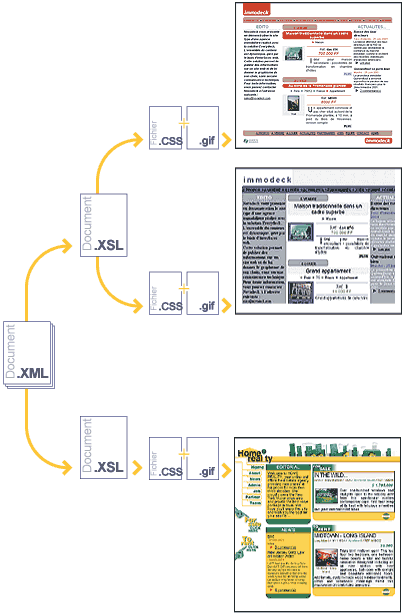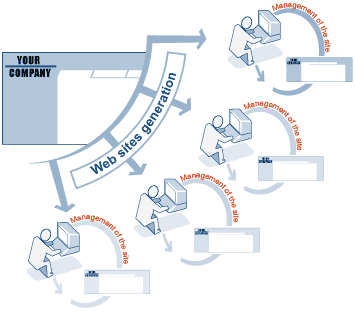Distributed intranet for a better knowledge management
A new approach of content management
Each entity of your company wishes to have the use of its own intranet site to publish and update information, and your direction wishes to impose a consistent charta in order to normalize exchanges? Intranet Content Management System by Novadeck enables you to federate information under a common format for autonomous sites hosted p, a single platform, in a single unified database.
| Advantages of such an approach are: |
 |
 |
a single multi-sites platform instead of numerous local servers, locally administered |
 |
 |
 |
each department publishes and manages content in its expertise domain, on its dedicated internal web site, and can manage its section in accordance with its administration rights, following the global charta |
 |
 |
 |
Information can be aggregated on the main unified portal. In reverse, a piece of news can be published on all the sub-sites of each division. |
 |
 |
 |
Each new entity of the company can immediately benefit from a site generated from the model. The site can then evolve depending according to the needs of the entity. |
 |
 |
 |
A search engine on published content gives access to information on a local or global basis. |
 |
 |
According to its company's communication policy, each intranet site can either be truly independent (with its own data structure, its own administration or navigation rights,its own URL or domain name, and of course its own content). It can equally share characteristics imposed by a model, and even share common content, managed on a centralized mode.
Towards efficient knowledge sharing
Each entity of the company can manage its information on its dedicated internal site. One or more administrators can affect editing rights to specialists in precise areas of the site. From there, it is possible to create a true knowledge base, constantly enriched by specialists in each sector. By democratizing access to public information and by encouraging specialists within the company to take part to the content publication, the company builds up its knowledge data, enlarges its global expertise, and condserably reduces the time necessary to find the right information. In reverses, acess to some rubrics or even to some of the sites can be limited in order to keep some private spaces when content is dedicated to a specific working group. Main features of the platfom
Separation between content and presentation
The conception of each content page follows this descriptive approach. It is limited to the description of types of data for each page, possibly under specific conditions, and integrated in a structuring XML framework . The resulting XML content is adapted to the display terminal (web browser, wap, etc.) by applying a standard XSL stylesheet, which enables various layouts of a unique content.
 |
Such an approach features unquestionable advantages: much shorter development time, lower technical level for site's creators, and interfaces' standardization. |
| Use of XSL sheets to change the presentation of a unique XML content |
 |
 |
 |
Multi-sites platform
A unique Novadeck's platform is able to handle a high number of various web sites, each ofthese sites having its own data's structures, its own design and navigation tree, its own domain name and naturallyits own content.
Nonetheless, it is possible to share both data and structures among the sites (for instance topublish a common content on all sites), or to apply the same presentation to various sites. Similarly, allthe sites on the platform can share the same users' base: a user can have different rights on differentsites and a single sign on system can ease the navigation between these various sites by keeping the visitor'sidentity from one site to the next, even if they are not hosted under the same sub-domain name.
 |
Visitors' tracking is common for the entire platform, which enables consolidated cross-sitesstatistics. |
| Redundant, fault tolerant cluster architecture of the Novadeck platform |
 |
 |
 |
Sites generation from a template
The descriptive nature of a web site's creation on a Novadeck's platform and its intrinsic multi-sites nature makeit possible to generate independent web sites on the basis of one site template.
The process is fairly easy: a web site model is created just like any independent web site. The content management'sengine derivates from it a template that will be applied to create a new web site: perfect clones, though totallyindependent from each other, can be created anytime. This enables to create a sites' network based on one singletemplate. According to the features of the template, derived sites may share or not some common attributes (as forinstance their graphical design or part of their content). This enables an harmonious and controlled lifecycle of the sites.
 |
This unique and original feature, directly resulting from Novadeck's technology's specificities, enablessolutions too heavy to put into place so far. It also gives the possibility to deploy in no time pre-formatted web sites answering specific, identified needs. |
| Dynamic web sites' generation from a template |
 |
 |
 |
Details of the functionalities
Data's structures
In order to structure content manageable on a web site, Novadeck has developed a flexible object oriented model,administered through a simplified web interface. Each data's object (typical basic structure such as an article, anemployee, a product in a catalog) is composed of fields which define the object.
Each field ban be mandatory (in this case, no object can be published if fields are not filled in) or not. Eachfield is characterized (numeric or alphanumeric, limited or unlimited number of characters or not, date, etc.).Besides, each field is multiple by principle, which means it can be filled in several times for each instance; theavailibity of this functionality is only constrained by the instances of the management's interface. Lastly, a fieldcan be defined as "redirect" i.e. it redirects towards another instance and its associated content, the identifierof the target instance being stocked in the redirect field.
When created, each instance of an object is automatically provided with general attributes such as author, creationdate, last modification's author, last modification's date: these attributes do not need to be managed in standardfields and are automatically updated.
 |
This enables the construction of complex data's structures that answer most of the needs that can be met in advanced content web sites' development. |
| Redirections between instances |
 |
![]() |
 |
Administration rights
The management of every content's object (create, modify, delete) is limited by a very precise administration'srights policy. Each field of an object can have different creation and modification rights (for instance the titleof an article can be created by a user having an editor's right, but it can only be modified by users with amoderator's right).
A specific right - owner- secures the fact that only the creator of an instance will be allowed to modify it.Deleting an instance is limited to the modification's rights of the fields of the instance.
 |
Such a system enables a large flexibility and accuracy in content management. Thenumber of administration's rights is not limited on the platform. |
Multilingualism
Each content's structure can be declined in as many languages as needed. Each site has a default language in whicheach content's element (for publication) must be instantiated. These primary instances can then be completed in oneor more additional language(s).
 |
<When the content is retrieved for publication, it is possible to precise the language in which it should be published (for each field of the object). If the field has not been translated in the specified language, content will be published in the primary language. |
Content publication
In order to be displayed on a web site, the content instance of an object must be published beforehand in apublication list. Publication lists' role is to distribute the content in the site. For example, instances of a sameArticle object's type can be posted in two different publication's lists depending on the section (for example Pressor References) where it should be published on a web site. The publication lists specify which content must appearon which page.
A single instance can be published on several publication lists (one single content for two different locations on asite). The publication of an instance can be specified for a given time ("publish the article tomorrow atmidnight"), and so the de-publication (in order to give an expiration date to non-permanent material). It is also onthe publication lists that the moderation process is operated: an instance can be marked as needing the validationof a user with a moderating right to be actually published on the site.
 |
The publication list is also a tool for information sharing between different sites: by defining a list as "exportable", one allows its use from a site different from the one where it has been created and administrated. Thus, a portal web site can easily share its news with another site of its commercial network. |
|
